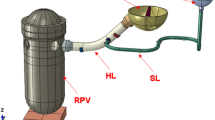Abstract
Owing to the fact that thermal fatigue is a well-known damage mechanism in nuclear power plants, accurate stress and fatigue evaluation are highly important. Operating experience shows that the design condition is conservative compared to the actual one. Therefore, various fatigue monitoring methods have been extensively utilized to consider the actual operating data. However, defining the local temperature in the piping is difficult because temperature-measuring instruments are limited. The purpose of this paper is to define accurate local temperature in the piping and evaluate thermal stress using Green’s function (GF) by performing a series of computational fluid dynamics analyses considering the complex fluid conditions. Also, the thermal stress is determined by adopting GF and comparing it with that of the design condition. The fluid dynamics analysis result indicates that the fluid temperature slowly varies compared to the designed one even when the flow rate changes abruptly. In addition, the resulting thermal stress can significantly decrease when reflecting the actual temperature.
Similar content being viewed by others
References
American Society of Mechanical Engineers, Environmental Effects on Components, App. W, Section III, Boiler and Pressure Vessel Code, ASME, New York, USA(2013).
J. S. Fuoto and W. R. Snyder, Reactor Coolant System Design Transients for Standard Plants, System Standard 1.3.F, Westinghouse, Pittsburgh, PA, USA(1978).
H. J. Shim, C. K. Oh, H. S. Kim, M. H. Boo and J. J. Kwon, New approach for fatigue damage monitoring based on actual operating history of nuclear power plant, Nuclear Technology, 190 (2015) 88–96.
A. Y. Kuo, S. S. Tang and P. C. Riccardella, An on-line fatigue monitoring system for power plant: part I -direct calculation of transient peak stress through transfer matrices and Green’s functions, Proc. of ASME Pressure Vessels and Piping Conference, Chicago, IL, USA(1986).
D. G. Jeong, S. Y. Rho, K. B. Yoon and C. K. Na, Development of thermal stress calculation algorithm for real time life monitoring of high temperature components, Trans. of KSME (A), 23 (8) (1999) 1338–1345.
E. L. Cranford, Fatigue monitoring using WESTEMS with automated data checking, Proc. of Nuclear Plant Fatigue Applications Workshop, Charlotte, NC, USA(2009).
M. H. Boo, E. S. Yun, C. K. Oh and H. S. Kim, Development of stress-based fatigue monitoring system based on the stress transfer function for nuclear power plants, Trans. of the Korean Nuclear Society Autumn Meeting, Pyeongchang, Korea(2014).
ANSYS, Inc., ANSYS Fluent user’s guide, Canonsburg, PA, USA(2014).
C. K. Oh, H. S. Kim, S. G. Jung and M. H. Boo, Thermal stress evaluation method using temperature dependent Green’s function, Proc. of KSME Materials & Fracture Division Conference, Jeju, Korea(2015).
M. H. Boo, S. M. Chung, C. K. Oh and H. S. Kim, A technical review on thermal stress evaluation method for stressbased fatigue monitoring of nuclear components and piping, Proc. of the K-PVP Annual Conference, Busan, Korea(2014).
ANSYS, Inc., ANSYS Mechanical user’s guide, Canonsburg, PA, USA(2014).
American Society of Mechanical Engineers, Material Properties, Section II, Boiler and Pressure Vessel Code, ASME, New York, USA(2013).
Author information
Authors and Affiliations
Corresponding author
Additional information
Recommended by Associate Editor Nam-Su Huh
Hyun-Su Kim received his B.S., M.S., and Ph.D. degrees in mechanical engineering from Sungkyunkwan University, Korea and MBA from Helsinki School of Economics, Finland. He is a Specialist on structural integrity assessment at KEPCO E&C. His research interests include fracture mechanics, computational mechanics, damage assessment, and residual life prediction for power plants.
Myung-Hwan Boo received his B.S. and M.S. degrees from Dong-A University and Ph.D. in material science from Kanazawa University, Japan. He has worked on aging management at Korea Hydro & Nuclear Power Co. His research interests include fracture mechanics, computational mechanics, aging management, damage assessment, and residual life prediction for power plants.
Rights and permissions
About this article
Cite this article
Boo, MH., Oh, CK., Kim, HS. et al. Numerical simulation of temperature and thermal stress for nuclear piping by using computational fluid dynamics analysis and Green’s function. J Mech Sci Technol 31, 2243–2249 (2017). https://doi.org/10.1007/s12206-017-0421-9
Received:
Revised:
Accepted:
Published:
Issue Date:
DOI: https://doi.org/10.1007/s12206-017-0421-9




